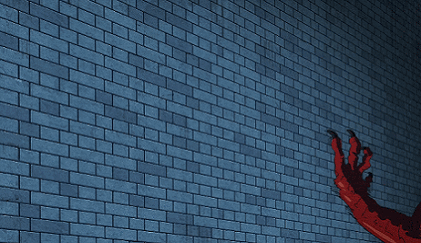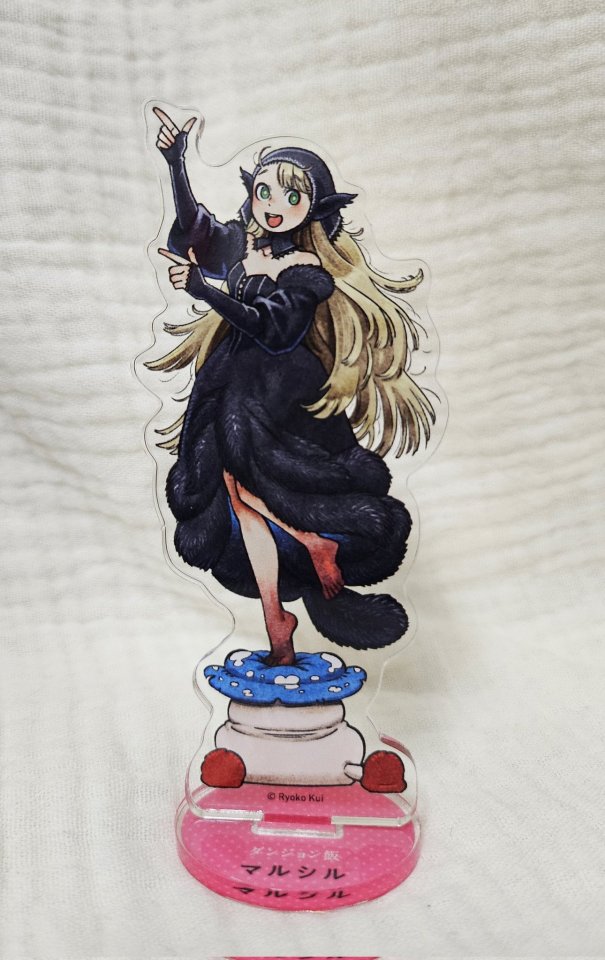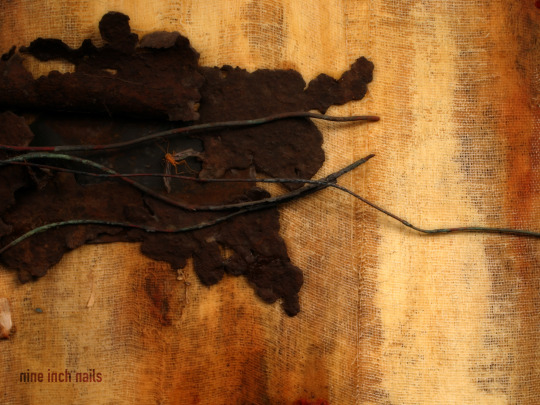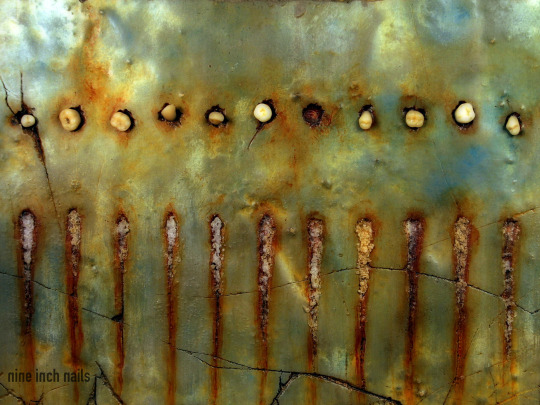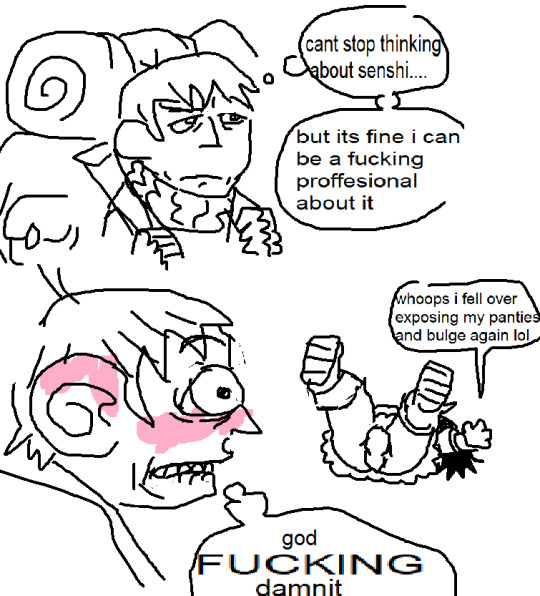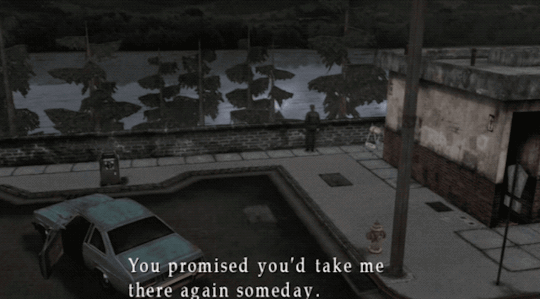Text
a threesome with two doms using you where one degrades you and the other praises you >>>
77K notes
·
View notes
Text
Semi-Realistic Troll Horn Tutorial
I know there are a kajillion of horn tutorials out there already, but I ended up using a method to make my horns that I haven’t seen written about yet. So just in case you guys are curious, here’s how I made my troll horns.
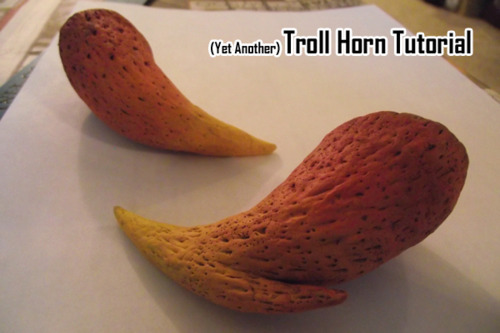
(Tons of pictures ahead, apologies in advance.)
FIRST! Please read the entire tutorial before running out and buying supplies - a lot of the stuff I used can be swapped with other things that you may happen to already have lying around your house. Save your money for other stuff!
For supplies, I used the following things:

Unpictured supplies include large snaps (the kind used in clothing), scraps of Wonderflex (any rigid material will do), hot glue, and a cheap wire cat brush.
The basic method I used to make my horns was this: I used the polyurethane expanding foam to carve out a base for my horns, then covered them in foil and Paperclay. After texturing the clay, I let them air-dry and painted them with acrylic paints. To attach them to my wig I used the snaps, Wonderflex, and hot glue.
(Also, this tutorial is sort of pieced together from pictures I took while making two sets of horns. Just in case you’re wondering why Mindfang’s horns suddenly change into Kanaya’s and vice versa.)
Part 1: Creating the Foam Base
Polyurethane expanding foam is awesome stuff to use when you need a lightweight, carve-able base for sculpting things. It’s usually sold in the insulation department of home improvement stores like Lowes or Home Depot. For my horns I used Fill & Seal, which was $3 per can.
First, protect your working area with parchment paper or wax paper. (In a pinch I suppose you could use newspaper, but the foam will stick to that. You’ll be carving off a good portion of the foam anyway though.) Attach the nozzle to the can and dispense some foam onto the parchment paper, creating some roughly horn-sized lumps. I have no idea how to clean the nozzle once foam has been through it, so I just kept making foam lumps until the can was empty. For me, it was about 7 or 8 medium-sized foam lumps per can. Keep the extras in case you screw up, or give them to friends who are also making horns. Let the lumps cure overnight, or at least for several hours.

Next, peel the foam off of the parchment paper and check to make sure you don’t have any humongous voids. If you don’t, then you’re good to go!
If you need to take a break, now is a good time. I unfortunately discovered that if you start carving the foam and leave it alone for a few hours, it will shrink and distort slightly (maybe about a 10-20% size change). It’s probably a good idea to set aside enough time to sculpt your foam bases and cover them in clay all in one sitting.
To sculpt the horns, I used a box cutter. The foam is fairly soft and flexible, so the box cutter slides through it really easily! The more blade of the box cutter you expose, the wider your cutting surface will be and the easier it will be to knock off large sections of foam. To remind myself of the general shape I wanted, I used a sharpie marker to trace an outline on the foam.
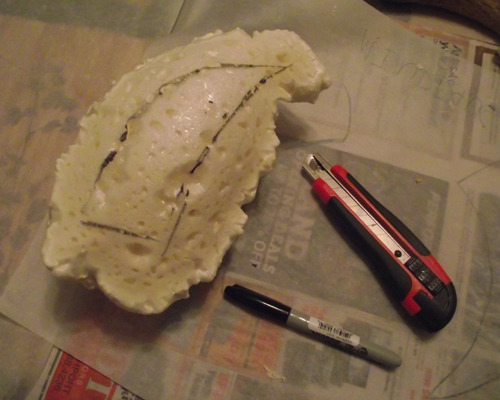
Here are the horns after I made the basic shaping cuts.

Knock off the edges and continue to sculpt them into the proper shape. Make sure you frequently compare the horns to each other to maintain symmetry.

Knock off part of the base of the horn so that it will be able to sit on your head properly. I had a mirror nearby and was holding these horns up to my head a LOT during the sculpting process to make sure I had the proper angulation and size.

In the end, you should get something like this!

You’ve probably noticed that the foam can get a lot of big air bubbles in it. If there are any large air bubbles in your horns at this point, you can tear up smaller scraps of the foam and shove them in the voids.
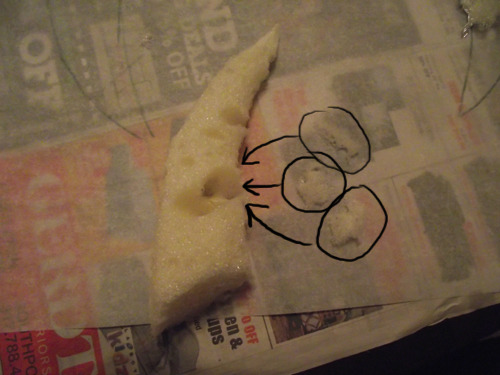
Part 2: Covering the Base
Cover the horn in tin foil. It doesn’t need to be a gigantic piece - I used a square whose diagonal width was slightly wider than the length of my horn. Make sure the piece of foil doesn’t develop small tears when you’re taking it off the roll, otherwise it’ll be a pain in the ass when you’re burnishing it.

Find something hard to burnish the foil with. I used the barrel of a highlighter and rubbed it over the foil to adapt it to the surface of the foam.

After I had covered and burnished both horns, I hacked off the end of one and added some copper wire to serve as a skeleton for Mindfang’s weird little claw thing. Note that for her other horn (which will have a hook on the end), I didn’t do anything. It’s up to you to choose which parts of your horns you want to use a wire base for, if at all.
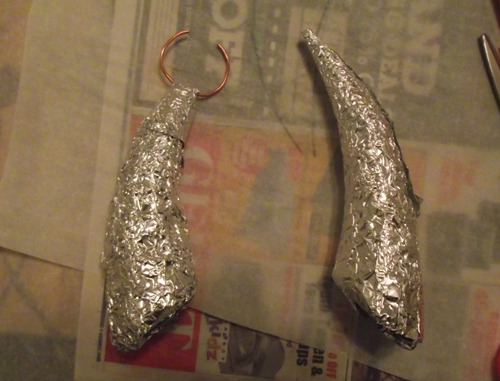
Next, get out your clay and begin coating your horns with it. (I highly suggest Paperclay - it is an air-dry clay that dries light and strong. Not all air-dry clays are the same! Stay away from Crayola brand Air Dry Clay, it is extremely dense and crumbly and pretty awful for this project.) If you don’t have a rolling pin to thin out the clay, the Fill & Seal can makes a great substitute. Keep a dish of water nearby so you can use it to blend the seams in your clay.

Sculpt whatever weird things you need on the ends of the horns, and be sure to blend the seams in with water.

The horns are now fully coated! Hooray! At this point the clay was too malleable for my liking and it kept squishing around in my hands every time I picked up the horns, so I let them dry for an hour or so before starting to add texture to them. The Paperclay dries pretty slowly, so you can afford to take a short break.

Part 3: Texturing the Horns
For this part, I was lazy and didn’t want to take a series of pictures, so you get a video of me rambling on about cow horns and shit for seven minutes. Enjoy!
After you’ve textured the horns, let them air dry overnight. (I’d like to point out that this is why I suggest a water-based clay instead of a polymer clay like Sculpey that requires baking in an oven. I have no idea what’ll happen if you stick polyurethane foam in the oven - it might catch fire or release some horrible death gas. Just use a clay that hardens via air exposure, please. ;_;)
Part 4: Painting the Horns
(My apologies - this section is kind of light on pictures because of camera issues.)
To paint the horns, I mixed up four colors using acrylic paint: dark brown, red, orange, and yellow. The dark brown goes on first as the base coat. Make sure you get the brown into all of the little nooks and crannies you created, but don’t just glop paint on either. If you lay on the paint too thickly, you’ll fill in all the little pores you worked so hard to create in the previous step! Let the base coat dry. When you add the lighter colors later, the brown will only show through in the recessed areas of your horns.
Next: using a small, short brush, begin painting on the yellow, orange, and red. (Technically, the trolls’ horns don’t have any red in them, but I like to add a little bit near the base of the horns anyway to give them a bit wider of a color range.) I used a technique called drybrushing to blend from one color to the next. Basically, you load only the tip of the brush with paint and dab it on your palette a few times to take off any excess paint. The paint should be applied to the horns using a brisk tapping motion rather than a series of long strokes. If your brush is appropriately loaded, the paint should be dry within seconds of its application.

When you’re done, you should have something like this!
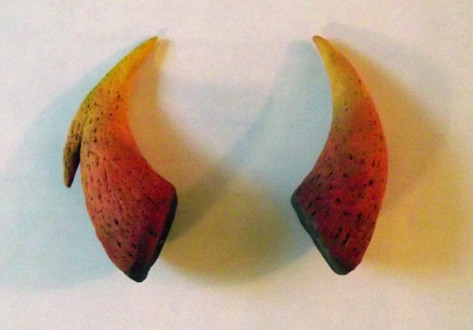
Part 5: Attaching the Horns
The cool thing about these horns is that they’re extremely light, so you don’t have to do a whole lot of work to attach them to your head! However, the following method requires that you wear a wig - apologies to those of you who want to use your real hair for troll cosplay.
To attach the horns to my wig, I cut out a circular base out of Wonderflex that was about as twice the diameter of my horns. (Wonderflex is a pretty nifty thermoplastic that you can mold with a blowdryer. You can buy some here, but it’s really not worth getting just for some troll horns. I just had a lot of scraps lying around. Any stiff material will probably work, even cardboard from a cereal box.) To make it easier for my fingers to get to the snaps, I cut out two C-shaped divets out of either side of each circle and rounded the resulting sharp edges.
Next, glue some large snaps (approximately ¼") to the base of your horns. With both pieces snapped together, add a dollop of glue to the free side of the snaps and press the base up against the snaps. This way the snap pieces on the horn and the snap pieces on the base will line up perfectly! Once the glue has cooled, carefully pry the snaps apart. If something separates where it shouldn’t, just peel the excess hot glue off and try again.

To attach the horns to your wig, simply sandwich the wefts of the wig between the snaps on your horns, and press the base and the horn together. Positioning the horns can get a little tricky, but once you’ve got them attached to the wig they’re not really going anywhere unless you want them to. This is what the inside of your wig should look like when the horns are in place.
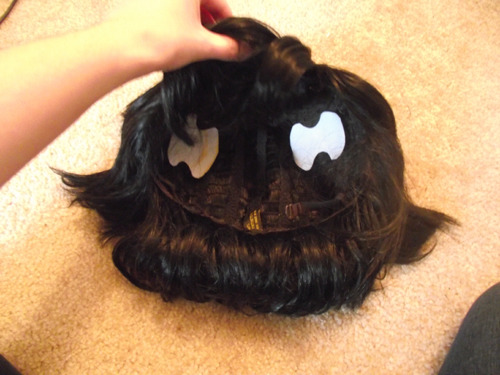
And voila! You get lightweight horns with no bothersome headband, and if you need the wig for something else all you have to do is unsnap the horns.
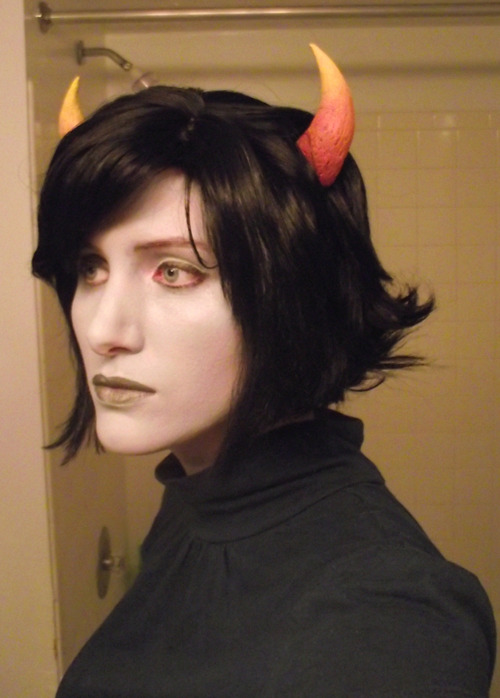
Happy trolling! >:3
Edit: A lot of people have asked me if the snap attachment method will work for larger horns, and I don’t know! Here is the best advice I can give for large horns until I actually have the opportunity to make a pair myself.
Edit 2: I have made a pair of Tavros horns! Here is a video I made about how to attach them. I ended up using a method that didn’t use snaps, but it still results in the horns being removable and no headband showing on the outside of the wig.
4K notes
·
View notes
Text
Reading amazing fanfiction, then forgetting to bookmark it

459K notes
·
View notes
Text
“do we think maybe a vegetable would cause less despair” still living in my head rent free
126K notes
·
View notes

